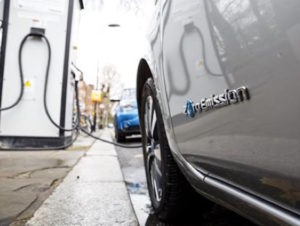UK health body urges fleets and local authorities to take action on air quality
UK fleets and local authorities could be called on to take action on air quality including training drivers on more efficient driving and through the use of clean air zones.

The NICE draft guidance says public sector fleets should consider switching to electric vehicles.
As the UK continues to grapple with harmful air pollution, health advisory body, the National Institute for Health and Care Excellence (NICE) has issued draft guidance urging fleets well as public sector transport services to consider introducing fuel-efficient driving as part of any test carried out when appointing or re-appraising staff who drive as part of their work.
The document, which is under consultation until 25 January 2017, also says public sector fleets should consider NO2 and particulates when making vehicle choices and look at switching to electric vehicles.
The document also suggests local authorities should look at lower speed limits and clean air zones, which could include restrictions for polluting vehicles as well as action to encourage the use of less polluting ways to travel. It adds that where traffic congestion is contributing to poor air quality, councils should consider incorporating a congestion charging zone within the clean air zone.
Other suggestions to councils include ‘no vehicle idling’ areas and redesigning speed bumps to avoid the need for acceleration and deceleration between them.
The report recommends taking a number of actions in combination, enhancing the small benefits of each action “cumulatively to produce significant change”.
Professor Paul Lincoln, chief executive of UK health forum and NICE guideline committee chair said: “Traffic-related air pollution is a major risk to the publics’ health and contributes to health inequalities.
“The NICE guidance sets out a strategic range of evidence-based practical measures to encourage low or zero emissions transport. This is very timely given the imperative to meet EU and national air quality standards.”
In response, RAC roads policy spokesman Nick Lyes said: “While only in draft form at this stage, there is a lot in NICE’s guidelines that is worthy of serious consideration when it comes to tackling air quality. No-idling zones, and the suggestion that local authorities should think again about speed humps which cause motorists to brake and then accelerate again, are eminently sensible suggestions and both have the potential to improve the quality of air locally. Empowering town and city planners to consider air quality when it comes to the location and new developments and infrastructure is also critical.
“Clean Air Zones will play their part in focusing on the most polluting vehicles, however the implications restricting certain vehicles from local areas needs to be carefully thought through. Other suggestions such as higher parking charges and more restrictions are also unlikely to reduce congestion and improve air quality – this could just push the problem elsewhere.”












